D'Addario Chromes Flatwound Guitar Strings Review
Review in brief: D'Addario Chromes Flatwound Guitar Strings
I've just recently written about D'Addario XL strings in my reviews. I got some new strings in today to replace some worn-out wires on my Ibanez AF75D hollowbody electric (yes, I still have/love the great Orange Punkin AF75D... forever a fan).
I think strings are a very personal thing, and as I've said before, this is not a fanboy point of view. This is a real, objective writing about some really wonderful strings. At some point, I'll cover other flatwounds... I can't always change strings every day to write tons of reviews - so I review the things I play and count on just as much as I write about what I like or don't like.
I use flatwounds on one fretted bass (an Epiphone EB-3 - YOW), my fretless bass, and on two Artcore hollowbodies. Flatwounds have a decidedly warm and smooth feeling to them. Although one can play them through a triple-Marshall-stack on full gain... the best use of them (for me, anyway) is to get that wonderful "mwah" warmth in my tunes.
I do have occasion to use flatwounds elsewhere - combined with good tubes and my trusty Analog Man SD-1 (Silver Mod). They really throw something different into the listener's ears! If you have a couple of different guitars at your disposal, you owe it to yourself to try some flatwounds.
On my Fender Jazz Fretless, I love and use nothing but Fender Flatwound bass strings. On one of my Artcores (Punkin), I only use D'Addario Chromes. Why? Fender and others make GREAT flatwounds, too... but I have a method and reason for my madness.
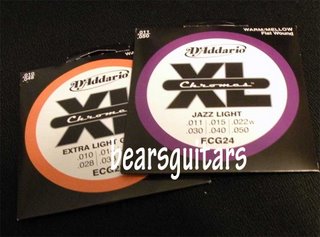
With my D'Addario XL Chromes Jazz Light (.011-.050) and D'Addario XL Chromes Extra Light Gauge (.010-.048), I get a SMOOTH third string. In most thicker flatwound sets for six-string guitars, the third string (generally a G string {no puns here}) is a wrapped string and not a plain string.
With Fender flatwounds, the third is a little course in texture, so you end up with an odd experience: 1, 2, 4, 5, and 6 feel smooth and silky. 3 grabs at your fingers. It's a disconcerting experience for me (personally) when I'm playing. I like all 6 strings (and 4/5 on my bass strings) to feel like slippery smooth wonders. NOTE: I do like the Fender flatwounds on my Bigsby-mounted Artcore AFS75T - the not-so-smooth G string has a nice growly sound to it for rockin' a little harder than my jazzier D'Addarios.
Remember, in my opinion, that strings and picks are integral to both the sound AND experience of playing guitars and basses... So, I go with Chromes on my feel-good Artcore AF75D.
So, where's the review? Right here:
Quality Every single D'Addario XL Chromes string I've ever installed and used has been ultra-consistent and very resistant to breaking. Each string has a profoundly comfortable consistency in wrapping and polishing.
Every single time I install a new set, they feel just like the last set did when it was new. Every single time. Interestingly, with flatwounds (irrespective of brand), it seems my flats last much longer than my roundwound strings... it is as though they don't trap as much "stuff" in them to corrode them...
In the past 5 years of playing flatwounds, I've
not had
even one D'Addario Chrome string break.
Sound Wow. Always. If you've fallen down on your sound and can't get up, it's worth the $8-$10 to try a set of Chromes! Each new set is like Christmas (or pick your holiday as your heart desires). I cannot wait to play them once they're on! Often as not, a new set of Chromes causes me to be inspired and record a new piece or start a new piece. It's wonderful.
Take a look at info and pricing for all kinds of D'Addario Chromes here at GuitarCenter.com
The sound is decidedly warm and comfy, and definitely jazz-like. It can smooth out even high-gain or distortion tunes, too.
One thing, though: they're not as brassy and bright as roundwounds, so flatwounds (in general) don't PUNCH through the tune's sound as much as everyday roundwounds. You might have to tweak your EQ a little and maybe turn up the volume and/or gain...
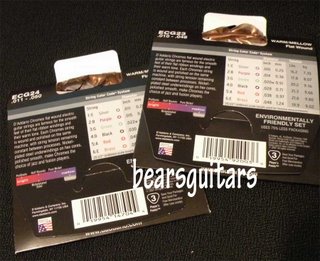 Value
Value Flatwounds, of every brand and type, are more expensive than comperable brand and size roundwounds. Most are wound, then polished in one or more extra steps. Some are ribbon-wound. Expect to pay a little more for a set.
But, my flatwounds (particularly my D'Addario Chromes) last as long as coated strings - without having to use coated strings. On average, my Chromes last three times longer than my roundwounds.
The packaging for chromes uses less materials, paper, and plastic... that usually means that they're a little "greener" than some of the other brands and types of strings I use. I like that part...
Conclusion D'Addario Chromes flatwounds are great strings. Try some. You might just get hooked! (BTW, some metal guitarists use flatwounds!)
Wishes None, really. I like them just as they are. I guess the only thing that would be bonus is if I could get them in colors :-).
Labels: Bass Strings, D'Addario, flatwound, Guitar Strings, jazz, mwah, smooth, warm
Fender American Jazz 4-String Bass Review
 Fender American Jazz Bass Review
Fender American Jazz Bass Review
There are many good and extremely good manufacturers of bass guitars in the world today. We have the luxury to access a huge variety of basses in all price ranges, lots of different styles and sounds, and a mind-boggling set of choices to make when shopping for a bass guitar.
When I set out to purchase a definitive bass for the majority of my bass playing (and recording), I wanted to have a great sound, a sound that fits many styles of music, and in a guitar that doesn’t require a second mortgage to own. I took several months to play lots of different basses from different manufacturers, and in lots of different price ranges. Although a musician like me wants to have lots of tonal/playing options for his guitars, I need a solid cornerstone instrument for my bass sounds: The Fender American Jazz fits the bill in a huge way. Our Fender American Jazz (“Count Bassy”), will be a member of the family – and a treasured heirloom for many years to come.
Quick Opinion: The Fender American Jazz bass is well-rounded, sonically rich, ultimately playable, and a joy in terms of playing comfort. If you need a long-term bass guitar – one that can fit almost any musical style – The American Jazz is just the prescription the doctor ordered.
Free Shipping and more information about the American USA Fender Jazz 4-String Bass here at GuitarCenter.com Playability:
Playability: I played about a dozen bass manufacturer brands before settling on an American Jazz. After long days of playing many basses, the American Jazz felt at once comfortable and effortlessly playable. The particular Jazz I purchased felt like playing an old favorite guitar of many years (just shiny, clean, and new).
The neck is the signature for a Jazz bass – a great taper, an effortless profile, and a satin finish that always feels effortless (even when your hands get hot and sweaty). The neck and body profile make for easy access to the entire fretboard range. As a bass player who loves to use the
entire fretboard, the Jazz feels right at home. It is obvious that the person who finished my particular Jazz neck paid attention to even the tiniest of details. (However, see my note at the end concerning the fret wire ends.)

The balance of the body and neck is outstanding for a full-scale (34”) bass. Even though my American Jazz is a tiny bit biased weight to the neck, it never becomes an issue for playing long hours in my home studio. The comfortable body contours for your ribcage and pick/thump/pluck hand arm make the guitar fit to the player like a glove.
Playing our Fender American Jazz bass is a comfortable and enjoyable experience. It’s easy to look forward to recording and playing sessions when one has one of these basses to play.
Features: Another place the American Jazz Bass shines is in its feature set. The vast majority of passive basses in this price range give you tone, volume, and some nice cosmetics. The Fender gives you nice cosmetics, and gives you the wonderful
S1 switch. The S1 switch gives you additional sound choices, and can add lots of real-world punch to your sound to cut through even a big, loud band.
My only concern with most passive basses is that it is very difficult to get lots of bass frequency (without sending your equipment/recording gear way into the clip-red-range). The balance between signal volume and
punch is a difficult thing to achieve, especially for recording. The S1 switch and the wonderful advanced-magnet pickups in the American Jazz make the search for sound MUCH easier to play, hear, and EQ.
The pickguard is a classy three-layer guard. The neck is a fabulous piece of maple (I chose the maple fretboard for its playability, sound, and looks). The tuners are accurate, easy to use, and simple to maintain. The included Fender hardshell case is wonderful for protecting your Jazz baby.
Sound: I could write a short novel about the sound of the Fender American Jazz bass. (Hey Fender, do you want me to write one?) There are lots of styles of music in the world, and there are lots of wonderful-sounding basses out there from a variety of manufacturers (even several different sounds from Fender). By far, the sound of the American Jazz bass fits more styles and sound qualities than any other bass I’ve had the pleasure of playing (followed closely by the Jazz’s cousin the Fender American Precision bass).
The sound is warm when you need it, it's very vibrant and broad when you tweak it, and there’s not much out there that can growl, sizzle, spank, bite, or punch better than the American Jazz. The Jazz is loud (for a passive bass) without being intrusive, but can take a lead tone in an R&B or rock tune very easily.
The sound of my American Jazz has inspired me to compose and record duets for bass, and has led me to intuitively play melody and counter-melody with the bass.
Value: The Fender American Jazz bass is well worth its cost, if not even a little more. The combination of quality, playability, and signature sound make the purchase of a Fender American Jazz a purchase you will long enjoy.
Wishes: My particular American Jazz plays like a dream – however, the ends of the frets have not been nicely dressed. I’m accustomed to American Fenders having all the little details done without compromise. If you run your hand down the edge of the fretboard against the edge of the fret wires, you can feel sharp, jagged edges. I used some fret polish paper to take a little of the bite off the edges of the wires – but they’re still not as clean as my American Telecaster.
Labels: 4 string bass, bass, electric bass, fender, jazz, usa
Squier Jazz Affinity Bass Long-Term Review
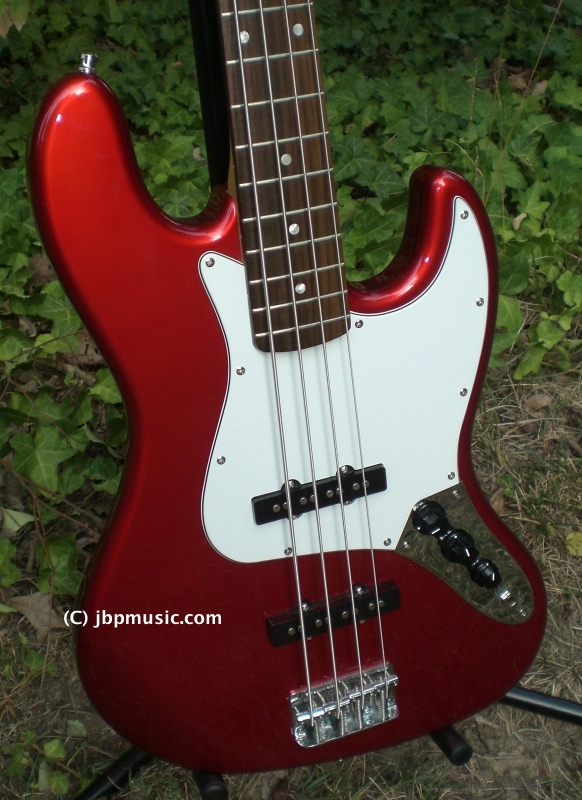 Squier Affinity J (Jazz) Bass long-term review
Squier Affinity J (Jazz) Bass long-term review
Every guitar player should try playing bass. It's a blast, and can really teach you something about fret stretches, silencing adjacent strings, and serious hand-strengthening. In another note, every bass player has to have a place to start. Sometimes getting a low-cost bass doesn’t mean having to get a
cheap bass!
Quick Opinion: The Squier Affinity and Standard Jazz Bass guitars are extremely comparable to Fender Mexican-made Standard Jazz Bass guitars! The basic features and appointments are almost identical. It stands to reason that the Chinese-made Squiers are slightly less-nice Alder wood, and the finish paint is thicker and harder on the Squiers. However, the impression of the Squier we bought (and have played for more than a year) is that it is a
solid buy, and an excellent bass.
 Free Shipping and more information about Squier by Fender Jazz basses - The Affinity 4-string Jazz may no longer be available, but check out the Vintage Modified!
Free Shipping and more information about Squier by Fender Jazz basses - The Affinity 4-string Jazz may no longer be available, but check out the Vintage Modified! Playability:
Playability: The neck is solid, and is nicely tapered. It is physically similar to Fenders costing much more… The maple neck and rosewood fretboard feel excellent and are easy to play. The bass is comparatively light and is fairly well balanced. The excellent Fender-designed double-cutaway body allows easy, full access to the entire fretboard.
As a long-scale (34”) bass, the Squier Jazz Bass is extremely playable and is a joy to use. The bolt-on maple neck/rosewood fretboard comes
surprisingly well finished. Only two or three of our guitar’s fret ends were a little sharp. The fret height is very consistent throughout the neck.
For folks with small hands or less-than-average arm lengths, a full-scale bass like this might be a little tough to play (especially during quick, challenging passes). If you’re not comfortable with a long, 34” guitar, I recommend trying out the Squier Bronco bass, or, if your budget can accommodate, a Fender Mustang bass.
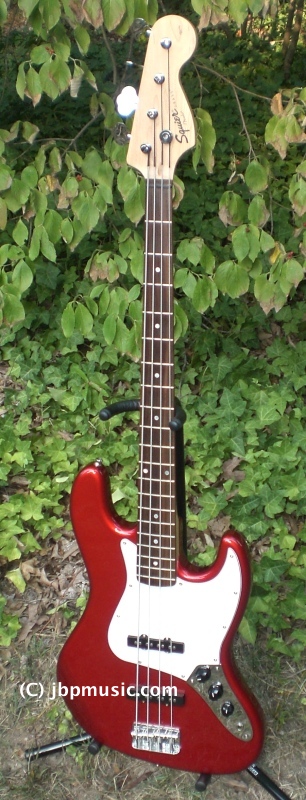 Features
Features The appointments and features of the Squier Jazz Bass are excellent for this guitar’s price. The pickguard is a well-made three-ply plastic guard (white-black-white on our Red Metallic bass). The pickups are two “vintage-style” pickups (bridge and mid). The guitar features two larger volume knobs and one smaller tone knob. The two volume knobs allow you to choose the tonal variety by selecting the volume for a specific pickup. The tone applies to the entire sound output (the Squier Jazz Bass guitars are
passive, in that they have no equalization or boost electronics on board). As with all Jazz Bass guitars, the neck is bolt-on. In the case of the Squier Jazz Bass, the neck truss rods are adjustable via an allen wrench in the headstock (no need to unbolt the neck and unscrew the pickguard). The chrome tuners are the enclosed variety, and are fairly accurate. The Squier Jazz uses a round string tree in the headstock for the two highest strings.
The Squier Jazz Bass has top-loaded strings (means that the strings are not fed through the body, but are fed through the end of the chrome bridge).
Sound: The Squier Jazz Bass guitar has a consistent, (sort of) vintage sound. The pickups are pretty noisy, and the output isn’t very strong. The quality of the sound that does come out is
all Fender, though. With the right amplification and EQ-tweaking, you can get the Squier to growl, rumble, and thumb-slap-“splank” without too much trouble. If I was to make this guitar my full-time bass – I might take the time to upgrade the pickups to Fender SCNs, or some type of high-output noiseless.
Value: This is a $299 guitar in value (not 'retail',
'street'). The sound, quality of make, and appointments are very good. Many other low-end guitars have badly twisted/warped necks, poor sound, and extremely cheap parts – the Squier Jazz Bass is very much a cut above the average low-end bass (no pun intended!). You would have to buy a much more expensive Fender bass to get better sound. If you took the labels off the Squier, you would have trouble telling it from its more expensive brethren (or sistren, if you wish).
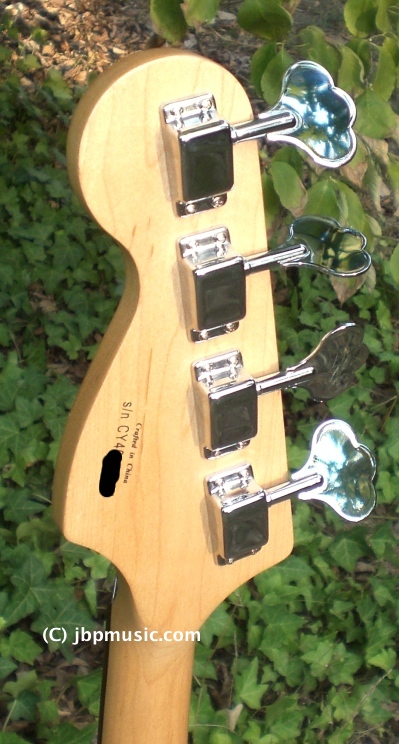 Wishes:
Wishes: I really wish these were offered with maple fretboards (a matter of personal preference, yes, but still something that would be good to offer). It would be nice if the pickups had more output.
Labels: 4 string bass, bass, electric bass, fender, jazz, squier








